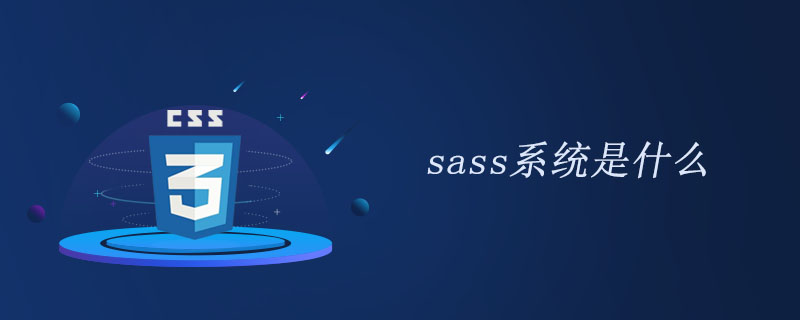what is sass system
SASS was born in 2007. It is the earliest and most mature CSS preprocessor. It has the support of the ruby community and compass, the most powerful CSS framework. Currently, influenced by LESS, it has evolved to SCSS which is fully compatible with CSS.

Sass (full English name: Syntactically Awesome Stylesheets) is a cascading style sheet language originally designed by Hampton Catlin and developed by Natalie Weizenbaum. After developing the initial version, Weizenbaum and Chris Eppstein continued to expand the functionality of Sass through SassScript. SassScript is a small scripting language used in Sass files. (Recommended learning: CSS3 video tutorial)
Sass is a scripting language that parses scripts into CSS, that is, SassScript. Sass includes two sets of syntax. The original syntax is called "indentation syntax", which is similar to Haml [3]. It uses indentation to distinguish code blocks and carriage returns to separate different rules. The newer syntax is called "SCSS" and uses the same block syntax as CSS, using braces to separate different rules and semicolons to separate specific styles. Typically, these two sets of syntax are distinguished by the file extensions .sass and .scss.
Sass extends CSS3, adding rules, variables, mixins, selectors, inheritance and other features. Sass generates well-formatted CSS code that is easy to organize and maintain.
Sass supports defining variables. Variables start with a dollar sign ($). Variables are assigned using colon (:).
SassScript supports four data types:
Value (can include units)
String
Color
Boolean type
Variables can be used as parameters or return values of functions. During the interpretation process, the interpreter writes the values of the variables into the final CSS file.
SASS is an expansion of the syntax of CSS3 (Cascading Style Sheet). It can use functions such as nesting, mix-in, selector inheritance, etc., and can write Stylesheet more efficiently and flexibly. Sass will eventually compile legal CSS so that it can be used by browsers, which means that its own syntax is not easy for browsers to recognize (although it is very similar to CSS syntax, almost the same) because it is not standard CSS. format, you can use dynamic variables etc. inside its syntax, so it is more like an extremely simple dynamic language.
For more technical articles related to CSS3, please visit the CSS3 Graphic Tutorial column to learn!
The above is the detailed content of what is sass system. For more information, please follow other related articles on the PHP Chinese website!

Hot AI Tools

Undresser.AI Undress
AI-powered app for creating realistic nude photos

AI Clothes Remover
Online AI tool for removing clothes from photos.

Undress AI Tool
Undress images for free

Clothoff.io
AI clothes remover

AI Hentai Generator
Generate AI Hentai for free.

Hot Article

Hot Tools

Notepad++7.3.1
Easy-to-use and free code editor

SublimeText3 Chinese version
Chinese version, very easy to use

Zend Studio 13.0.1
Powerful PHP integrated development environment

Dreamweaver CS6
Visual web development tools

SublimeText3 Mac version
God-level code editing software (SublimeText3)

Hot Topics
 1385
1385
 52
52
 How to use bootstrap in vue
Apr 07, 2025 pm 11:33 PM
How to use bootstrap in vue
Apr 07, 2025 pm 11:33 PM
Using Bootstrap in Vue.js is divided into five steps: Install Bootstrap. Import Bootstrap in main.js. Use the Bootstrap component directly in the template. Optional: Custom style. Optional: Use plug-ins.
 The Roles of HTML, CSS, and JavaScript: Core Responsibilities
Apr 08, 2025 pm 07:05 PM
The Roles of HTML, CSS, and JavaScript: Core Responsibilities
Apr 08, 2025 pm 07:05 PM
HTML defines the web structure, CSS is responsible for style and layout, and JavaScript gives dynamic interaction. The three perform their duties in web development and jointly build a colorful website.
 How to write split lines on bootstrap
Apr 07, 2025 pm 03:12 PM
How to write split lines on bootstrap
Apr 07, 2025 pm 03:12 PM
There are two ways to create a Bootstrap split line: using the tag, which creates a horizontal split line. Use the CSS border property to create custom style split lines.
 Understanding HTML, CSS, and JavaScript: A Beginner's Guide
Apr 12, 2025 am 12:02 AM
Understanding HTML, CSS, and JavaScript: A Beginner's Guide
Apr 12, 2025 am 12:02 AM
WebdevelopmentreliesonHTML,CSS,andJavaScript:1)HTMLstructurescontent,2)CSSstylesit,and3)JavaScriptaddsinteractivity,formingthebasisofmodernwebexperiences.
 How to resize bootstrap
Apr 07, 2025 pm 03:18 PM
How to resize bootstrap
Apr 07, 2025 pm 03:18 PM
To adjust the size of elements in Bootstrap, you can use the dimension class, which includes: adjusting width: .col-, .w-, .mw-adjust height: .h-, .min-h-, .max-h-
 How to set up the framework for bootstrap
Apr 07, 2025 pm 03:27 PM
How to set up the framework for bootstrap
Apr 07, 2025 pm 03:27 PM
To set up the Bootstrap framework, you need to follow these steps: 1. Reference the Bootstrap file via CDN; 2. Download and host the file on your own server; 3. Include the Bootstrap file in HTML; 4. Compile Sass/Less as needed; 5. Import a custom file (optional). Once setup is complete, you can use Bootstrap's grid systems, components, and styles to create responsive websites and applications.
 How to insert pictures on bootstrap
Apr 07, 2025 pm 03:30 PM
How to insert pictures on bootstrap
Apr 07, 2025 pm 03:30 PM
There are several ways to insert images in Bootstrap: insert images directly, using the HTML img tag. With the Bootstrap image component, you can provide responsive images and more styles. Set the image size, use the img-fluid class to make the image adaptable. Set the border, using the img-bordered class. Set the rounded corners and use the img-rounded class. Set the shadow, use the shadow class. Resize and position the image, using CSS style. Using the background image, use the background-image CSS property.
 How to use bootstrap button
Apr 07, 2025 pm 03:09 PM
How to use bootstrap button
Apr 07, 2025 pm 03:09 PM
How to use the Bootstrap button? Introduce Bootstrap CSS to create button elements and add Bootstrap button class to add button text




